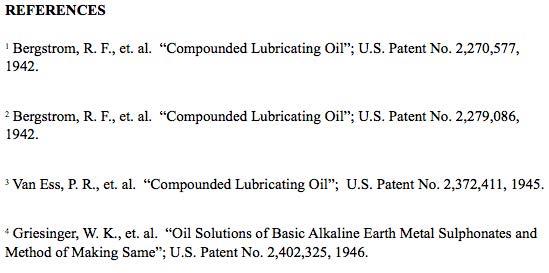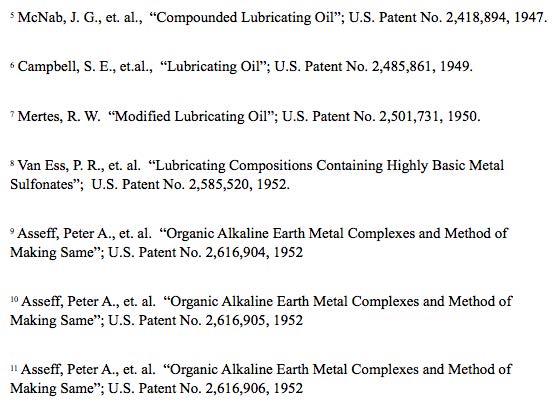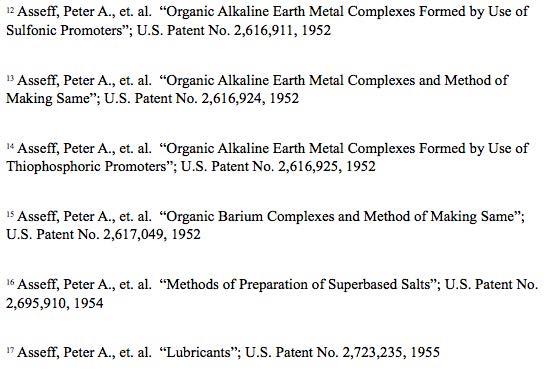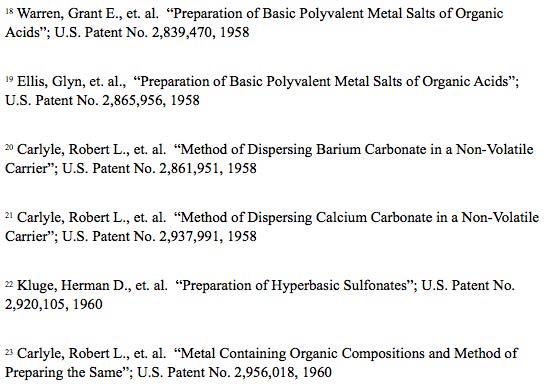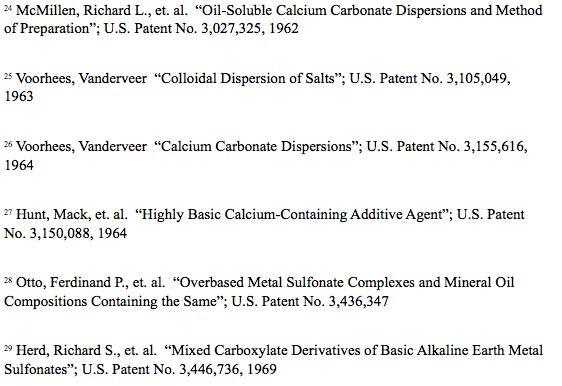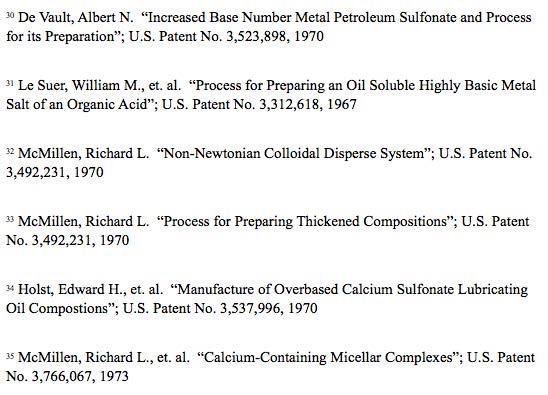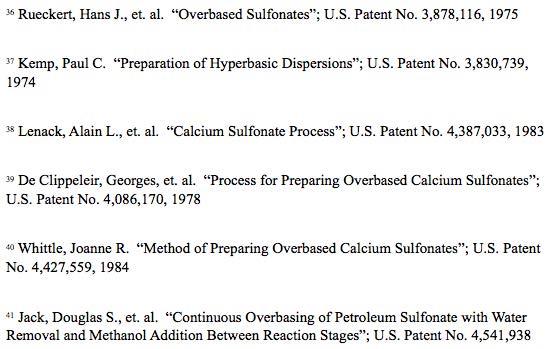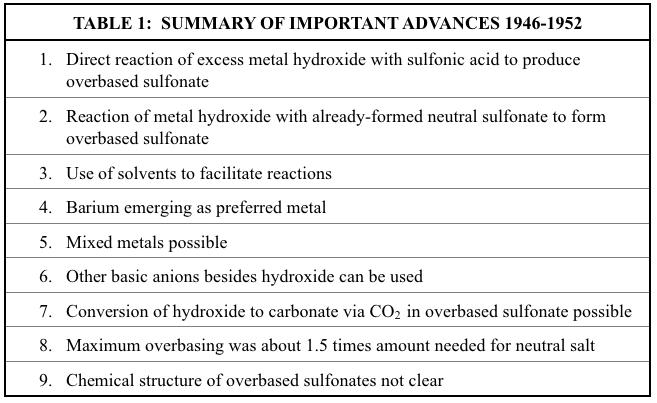
43 minute read
Days of Future Passed: A Critical Review of the Development of Highly Overbased Calcium Alkylbenzene Sulfonates
Days of Future Passed:
A Critical Review of the Development of Highly Overbased Calcium Alkylbenzene Sulfonates
J. Andrew Waynick
NCH Corporation
ABSTRACT
Highly overbased calcium alkylbenzene sulfonates have become an important component in numerous industrial lubricants including passenger car and heavy-duty diesel engine oils, metalworking fluids, and calcium sulfonate-based lubricating greases. The latter category was, by definition, not even possible without the development of these important raw materials. The development of highly overbased calcium sulfonates began in 1942 and has continued to the present. However, as far as the author can determine, this technology development has never been reviewed in any dedicated or organized way. This paper provides such a review by concentrating on the primary source involved: the U.S. Patent literature. By systematically and critically reviewing the more than 40 U.S. Patents from 1942 to 2000 that span the development of highly overbased calcium alkylbenzene sulfonates, a picture becomes visible that provides a clearer understanding of the current calcium sulfonate-based grease technologies that use these additives. It also clearly highlights a major gap in understanding of this area of additive chemistry previously not discussed in the open literature. The recognition of this gap sets the stage for future work needed to better understand overbased alkylbenzene sulfonate chemistry and provides a new tool for the development of improved calcium sulfonate-based greases. The organization of the large amount of developmental information represented in this review paper is cast within the metaphor of a typical 24 hour day, starting just before dawn and concluding with the arrival of night – appropriate since the story of most new technology development conforms to such a picture.
THE DAY BEGINS (1942-1945)
Pinprick holes in a colorless sky, Let insipid figures of light pass by, The mighty light of ten thousand suns, Challenges infinity and is soon gone…
Brave Helios, wake up your steeds, Bring the warmth the countryside needs.
-Graeme Edge
Today’s calcium sulfonate-based greases have as their central component highly overbased calcium alkylbenzene sulfonates. However, the impetus for the original development of those materials had nothing to do with lubricating greases, but was instead related to crankcase oils for gasoline-powered passenger cars. As the performance demands for those engine oils had increased, so had the problems of piston ring sticking and varnish buildup. In the early 1940’s, the use of performance-improving additives for motor oils
was still in its infancy. Three U.S. Patents, all filed in 1940 by Shell Development Company and issued between 1942 and 1945, addressed this problem with the development of additives based on oil-soluble metal alkylbenzene sulfonate salts,,. The preferred metals were those that had only one stable oxidation state; Ca, Mg, Ba, Al, and Zn were specifically mentioned. It was taught that the sulfonate salts could be either neutral or basic, with a mixture of both being preferred. However, all examples used already prepared calcium sulfonate salts with no mention as to how they were prepared or whether they were neutral, basic, or a mixture of neutral and basic. No art prior to those three patents could be found that provided any specific methods to prepare basic sulfonate salts, so there was apparently no obvious perspective that would have been easily known by those who first read those patents.
The remaining aspects of those three patents dealt with other motor oil additive components that were used to augment the metal sulfonate salts and provide additional benefits such as oxidation inhibition and further corrosion protection. This admittedly inauspicious beginning set the stage for the dawn of the development of the first documented basic metal alkylbenzene sulfonates.
DAWN (1946-1952)
You look around you Things they astound you So breathe in deep You’re not asleep Open your mind.
-Mike Pinder
A series of five U.S. Patents, each assigned to a different company (except one for which the assignees were the inventors) represented the first disclosed technology for specifically forming overbased metal sulfonates,,,,. The first of these patents, assigned to Atlantic Refining, described the reaction of sulfonic acids (formed by sulfonating a hydrocarbon oil) with about twice the stoichiometric amount of hydrated lime (calcium hydroxide) by hot air agitation and direct steam heating at about 220 F to 230 F for one to two hours to produce an overbased sulfonate4. No demonstration of structure was provided, and the final overbased sulfonates were considered as halfneutralized salts. Although no actual examples were provided, the chemistry described could be written as follows:
(1) 2RC6H4SO3H + 2Ca(OH)2 (RC6H4SO3)2Ca.Ca(OH)2 + 2HOH
A second patent focused primarily on reaction of metal salts of alkylbenzene sulfonic acid with either elemental sulfur or a sulfide of phosphorus5. Presumably the reaction takes place across the olefinic unsaturation of the alkyl groups on the sulfonate. Although this patent did not advance the development of overbased calcium sulfonates, it did claim that the neutral metal sulfonate could be formed using bases that included not only metal oxides or hydroxides, but also metal sulfides, alkoxides, hydrides, or carbides. This concept would be used in later advances. Also, this patent introduced the concept of reacting an already formed neutral metal alkylbenzene sulfonate with inorganic metal salts including metal hydroxide. The resulting materials were claimed to be basic metal alkylbenzene sulfonates where the structure was that of a coordination complex. However, no evidence was provided to support this assertion. The examples were limited to one overbased barium alkylbenzene sulfonate and one overbased calcium tetra-isobutylphenol sulfonate. Prior to reaction with sulfur, the formation of the basic sulfonate salt in the first example would be represented by the following two reactions:
(2) 2RC6H4SO3H + Ba(OH)2 (RC6H4SO3)2Ba + 2HOH
(3) (RC6H4SO3)2Ba + xBa(OH)2 (RC6H4SO3)2Ba . xBa(OH)2
The precise amount of overbasing in these two materials could not be calculated from the information provided, but it was clearly only a small amount. Therefore, x in reaction (3) was likely less than or equal to 1.
A third patent dealt specifically with the preparation of basic metal alkylbenzene sulfonates using the same general approach as the above reactions (2) and (3)6. However, in this case, the neutral sulfonate salt was first formed using methanol/water as a solvent. Then, additional hydroxide of the same metal was added and the mixture was heated in the same solvent system. Interestingly, this patent also claimed the direct use of added metal carbonates, but nowhere provides any examples of this. Although all alkaline earth metals are taught, all three examples use only barium. The amount of overbasing in the final product was 2.5 times the amount needed for a neutral salt. Thus, the value of x in the above reaction (3) would be 1.5 as it applied to this technology.
The next patent in this series of five continued the approach of the previous two in that the overbasing was accomplished by reaction of a metal-containing base with an already formed neutral metal sulfonate7. No examples were provided in this patent. However, several important new concepts were introduced. First, the metal-containing base could be either hydroxide, oxide, carbonate, or bicarbonate. Second, the metal in the added base was often different from the metal in the neutral sulfonate, with sodium hydroxide often being mentioned. Most importantly, the concept of converting a final hydroxide-overbased sulfonate to the carbonateoverbased sulfonate by reaction with carbon dioxide was introduced. This was a key development that would prove vital in much of what would follow. As with earlier patents, barium appeared to be preferred in obtaining a stable product with significant overbasing. The inventors suggested that the structure of their products was a colloidal suspension. They based this on the amount of metal-containing salt present as well as the observation that their products exhibited the Tyndall Effect.
The final patent in this series taught the formation of a neutral alkaline earth metal alkylbenzene sulfonate by first forming the sodium salt and then performing a metathesis reaction with the hydroxide of the desired alkaline earth metal8. All examples used either calcium or magnesium. Overbasing was accomplished by first forming the neutral metal alcoholate, then reacting it with the neutral sulfonate to form a complex. The complex was then reacted with water to convert the alcoholate to hydroxide. Thus, this patent continued the general concept introduced in the previous patent of chemically modifying the overbasing structure after the stable overbased sulfonate has been formed. The inventors posed a possible structure for these overbased materials, but presented no evidence to support it. Significantly, they made a point of not being bound to any structural theory regarding their claims. In view of what is now known about chemical bonding, their proposed structures seem unlikely.
Key advances from the patents of this section are summarized below in Table 1.
Yesterday’s dreams Are tomorrow’s sighs
-Ray Thomas
A series of nine patents by Peter A. Asseff and co-workers, assigned to Lubrizol and issued between 1952 and 1955, represented a landmark advance in the synthesis chemistry of overbased alkaline earth metal alkylbenzene sulfonates,,,,,,,,. Most of the information found in each of these patents overlap to the others with even most of the more than 74 examples being the same. Accordingly, they will be treated as one entity instead of nine. As with all the previous patents, the driving force behind this work was the development of improved motor oil additives that could mitigate the buildup of acidic materials and varnish within critical engine areas such as piston rings, cylinder liners, and bearings.
The synthesis approach taught in all nine Lubrizol Patents was as follows:
(4) 2RC6H4SO3H + (x+1)M(OH)2 (RC6H4SO3)2M . xM(OH)2 + 2HOH
or
(5) (RC6H4SO3)2M + xM(OH)2 (RC6H4SO3)2M . xM(OH)2
The key feature of this approach that distinguished it from earlier patents was that the reactions were done in the presence of water and a material called a promotor.
The term “promotor” as it applies to the synthesis of overbased metal sulfonates was used for the first time in these Lubrizol patents. Promotors were required to conform to either the formula AH or AXH, where A is an organic radical, X is either oxygen or sulfur, and H is hydrogen. Specific suggested promotors included phenolic compounds, low molecular weight sulfonic acids, alkyl nitro compounds, and thiophosphoric acids. The common structural feature of all these promotors is that they contain either acidic or tautomeric hydrogen. It should be noted that non-aromatic alcohols were not included in this initial definition of a promotor.
As indicated by both reactions (4) and (5), the Lubrizol patents taught that the starting material could be either the alkylbenzene sulfonic acid or a neutral metal salt thereof. However, starting with the sulfonic acid was taught as preferred so as to advantageously differentiate this new technology from prior patents where the already formed neutral salt was required or preferred. Even so, most of the synthesis examples in the Lubrizol patents started with an already formed neutral metal sulfonate salt.
For the first time, these patents taught that the commonly used neutralization number method (later re-defined as acid number, and later still as total acid number, TBN) was not always reliable to determine the extent of actual overbasing. The concept of metal ratio was, for the first time, introduced as a superior alternative, where the metal ratio was defined as:
Metal Ratio = %(wt) metal in overbased product %(wt) metal in neutral product
The Lubrizol patents claimed that the highest metal ratio achieved prior to their work was 2.3, and they included two comparison examples using prior art techniques to demonstrate it. They also pointed out that none of the different chemical structures of overbased sulfonates proposed in the prior art had any real basis for proof. Instead of proposing a chemical structure themselves, Asseff and co-workers simply stated that the chemical structure was not well-understood.
The Lubrizol patents also taught the use of either CO2 or SO2 as a post-treatment to the overbased metal alkylbenzene sulfonate. This concept had been first introduced in a previous patent7, but the utility of this technique was further defined by Lubrizol.
The post-treatment was done for two reasons: first, to neutralize the promotor so that it could then be stripped off by distillation; second, to convert the hydroxide to carbonate or sulfite. Examples indicated that carbonate was preferred. Several examples showed that when CO2 post-treatment was done, the metal ratio of the overbased material did not change. This observation proved that metal ratio was indeed a superior method of determining extent of overbasing compared to neutralization number, since the neutralization number of the carbonated product often was significantly reduced. It also showed that the CO2 post-treatment did not increase the amount of overbasing.
One of the nine Lubrizol patents provided a more involved reaction process that provided even higher metal ratios16. This process had been discussed and used in examples in the other Lubrizol patents, but it was the specific focus of this patent. In this process, Asseff and co-workers referred to all prior art basic sulfonates as “basic salts”. They referred to their products of reactions (4) or (5) as “organic salt complexes”. In creating this name they apparently were not implying any particular chemical structure such as a true Warner complex. In the improved process described in this patent, an organic salt complex from (4) or (5) was first reacted with CO2 or SO2
to convert hydroxide overbasing to carbonate or sulfite overbasing. Then, the resulting carbonate or sulfite-overbased organic salt complex was reacted with additional metal hydroxide to further increase the amount of overbasing. This additional reaction with metal base could be done with or without water and promotor. Finally, the product could be reacted again with CO2 or SO2 to convert the newly obtained hydroxide overbasing to carbonate or sulfite overbasing. Not including the initial water or promoter in the equations, the reaction chemistry described with conversion to carbonate could be written as follows:
(6) (RC6H4SO3)2M . xM(OH)2 + xCO2 (RC6H4SO3)2M . xMCO3 + xHOH
(7) (RC6H4SO3)2M . xMCO3 + yM(OH)2 (RC6H4SO3)2M . xMCO3 . yM(OH)2
(8) (RC6H4SO3)2M . xMCO3 . yM(OH)2 + yCO2 (RC6H4SO3)2M . (x+y)MCO3 + yHOH
Asseff and coworkers referred to the final products of this reaction process as “superbased salts”.
Collectively, the nine Lubrizol patents provided more than 74 detailed synthesis examples, with metal ratios reported for nearly all of them. Metals used were barium, calcium, and strontium. At least 62 examples used barium. The highest metal ratio achieved for an overbased barium sulfonate using the general reaction process of reactions (6) through (8) was 9.3. Most barium metal ratios were between 3.0 and 5.5 when the more simple process of reactions (4) or (5) were used. Only six examples used calcium as the metal. Metal ratios for those samples were: 1.57, 1.53, 2.36, 1.29, 3.07, and 3.94. One sample used strontium, and its metal ratio was 1.67. Empirical formulas were provided for the final products in the examples of two of the Lubrizol patents10,17. The inventors openly claimed that all overbasing techniques thus far documented, including theirs, worked best when barium was the metal. Clearly, their own data showed this to be so. However, no chemical reason for this was suggested.
Key advances from the patents of this section are summarized below in Table 2.
PEAK HOUR (1958-1962)
I see it all through my window it seems, Never failing, like millions of bees… Minds are subject to what should be done, Problem solved, time cannot be won… Peak hour…

It was more than two years after the final of the nine previously discussed Lubrizol patents before the issuance of another significant patent dealing with overbased metal sulfonates. That patent, issued to Shell Development Company in 1958, provided the next important advance in this developing technology. Unlike earlier patents, this one primarily used calcium instead of barium. Promotors were not used. A neutral calcium alkylbenzene sulfonate was reacted with calcium hydroxide, water, and CO2 with heat.
Unlike all previous patents where CO2 was only used to convert hydroxide overbasing to carbonate overbasing in an already formed overbased sulfonate, this patent taught the use of CO2 as a reactant to actually increase the level of overbasing. The inventors claimed that calcium carbonate was formed in situ and then reacted with the neutral calcium sulfonate to form the unspecified overbased structure. However, they also claimed that this process would work when starting with the alkylbenzene sulfonic acid instead of the neutral sulfonate salt. They showed in two comparative examples that a stable overbased calcium sulfonate could not be formed if the sulfonic acid was reacted directly with added calcium carbonate. For the synthesis to be successful, the calcium carbonate needed to be formed (by reaction with the calcium hydroxide and CO2) as the overall reaction process occurred. This contradicted an earlier patent that claimed (without supporting data) that added metal carbonate could be used6 .
Most of the 20 examples started with a neutral calcium sulfonate; one started with a neutral barium sulfonate. Two started with a sodium sulfonate which was reacted with calcium chloride to form the neutral calcium sulfonate. The extent of overbasing was measured in all examples by base number. The highest base number achieved was 162 in an example that used three sequential overbasing, stripping, and filtration stages.
For the first time, this patent taught that for optimum product stability, not all the calcium hydroxide should be carbonated. The reaction chemistry, omitting the initially added water, can be described as follows:
(9) (RC6H4SO3)2Ca + xCa(OH)2 + (x-n)CO2 (RC6H4SO3)2Ca.(x-n)CaCO3. nCa(OH)2 + (x-n)HOH
A second related Shell patent issued later the same year and was similar in its general approach. However, it differed from the previous Shell patent in that most of the examples used organic acids other than alkylbenzene sulfonic acids. The most common acid used was alkyl salicylic acid. Also, an alcohol, usually methanol, was added as well. The inventors claimed that the alcohol helped to provide a more stable overbased product during the process whereby the calcium carbonate was formed in situ as the acid was neutralized and overbased. The inventors did not claim the use of a promotor, and as already mentioned, the earlier Lubrizol work by Asseff and coworkers did not include non-aromatic alcohols as promotors. However, based on work that would later be published, it is likely that methanol was indeed acting as a promotor. The highest metal ratio reported was 11, and was achieved by using an alkyl naphthenic acid. As with the earlier Shell patent, the inventors claimed that it was important to not convert all the added calcium hydroxide to the carbonate.
Two patents issued to Continental Oil Company provided additional methods to prepare overbased sulfonates,. The first dealt specifically with using barium, preferably as barium oxide dissolved in methanol, as a reagent20. The alcoholic barium oxide solution, water, and CO2 were reacted with either a neutral sulfonate salt or a sulfonic acid. Most of the 22 examples used postdodecylbenzene sulfonic acid as the starting material. Base numbers ranged from 68 to 133. One example used a neutral calcium postdodecylbenzene sulfonate that was overbased with methanolic barium oxide.
In a related patent that issued two years later, this technology was adapted to using calcium oxide or hydroxide instead of barium oxide21. In order to overcome the poor solubility of the calcium bases in methanol, they were first converted to the more soluble calcium sulfide by reaction with H2S. The calcium sulfide was then dissolved in methanol and reacted with postdodecylbenzene sulfonic acid, water, and CO2. Highest base number achieved was 108. Electron micrographs showed that the resulting barium and calcium hydroxide in the overbased products were typically smaller than 0.03 microns. As with all patents discussed thus far in this paper, no mention was made as to whether any crystallinity was observed. As with the previously discussed Shell patents, the methanol used in these two Continental Oil Company patents may have been acting as a promotor even though the inventors made no such claim.
The next two patents both involved interesting ways to “trick” additional calcium hydroxide into an overbased structure by first forming another, less stable calcium-containing base that apparently more easily attached itself to the neutral sulfonate salt22,23. Then the unstable base was decomposed to leave the calcium hydroxide in place as the overbasing species. The first of these two patents was issued to Texaco and described a novel method of reacting a neutral metal alkylbenzene sulfonate, water, and a metal alkoxy ethanolate to produce a hydroxide overbased sulfonate and alkoxy ethanol that was stripped off. The resulting overbased sulfonate could
optionally be reacted with CO2 to convert the hydroxide overbasing to carbonate overbasing. Most examples used magnesium, although barium and calcium were also used. The reaction (without the carbonation step) can be described as follows:
(10) (RC6H4SO3)2Mg + xMg(OC2H4OR)2 + 2xHOH (RC6H4SO3)2Mg . xMg(OH)2 + 2xHOC2H4OR
Although the authors claimed that promotors as per the prior Lubrizol patents were not used, it is possible that the alkoxy ethanol formed during the hydrolysis reaction generated an effective promotor in situ. Metal ratios of 2-3 were obtained. So, while the chemistry is interesting, it did not seem to advance the ability to provide even higher levels of overbasing compared to previously reported work.
The second patent dealing with a novel way to introduce overbasing to alkylbenzene sulfonates and other organic dispersing agents was issued to Continental Oil Company in 1960. The unique feature of this patent was that a metal base (usually calcium hydroxide) was dispersed in an alcohol (usually methanol) and reacted with CO2 to form an alcoholinsoluble compound that was identified as a very specific methyl O-substituted calcium carbonate-methanol complex with the following structure:
(11) Ca(-O-CO-OCH3)2 . nCH3OH
This complex was then added to a dispersant (such as a neutral calcium alkylbenzene sulfonate), and the mixture was heated to decompose the complex and strip off the methanol, thereby leaving the resulting calcium carbonate dispersed as part of an overbased product. Base numbers for the examples were typically between 50 and 90, although two samples had base
Finally, in another important patent issued in 1962, Lubrizol incorporated the feature of using CO2 to actually increase the extent of overbasing into the technology that they had developed during 1952-1955. The patent was specifically for overbased calcium sulfonates. The chemistry involved reaction of a neutral calcium alkylbenzene sulfonate with calcium hydroxide, water, CO2 and an alcohol at a typical temperature of about 40 C. The term “promotor” was not used in this patent. Even so, based on later Lubrizol work discussed in the next section of this paper, it is likely that the alcohol was functioning as a promotor. The preferred alcohol was methanol, making it even more likely that some of the earlier patents that used methanol as a solvent were actually benefiting from its role as a promotor. Metal ratios of 7-8 were taught, with the highest value obtained in any example being 7.1. It should be noted that a specific step by step mechanism for the overbasing reaction that defined the exact roles of water and promoter was not proposed or even mentioned in this patent or in any previous one.
This Lubrizol patent is important for two reasons. First, it included for the first time all the compositional and process features used today for the manufacturing of 400 TBN overbased calcium sulfonates. Second, the primary inventor, Richard L. McMillen, was the person who would only four years later be the primary inventor for the first overbased calcium sulfonate-based grease patent. This fact is almost certainly not coincidental.
Key advances from the patents of this section are summarized below in Table 3.
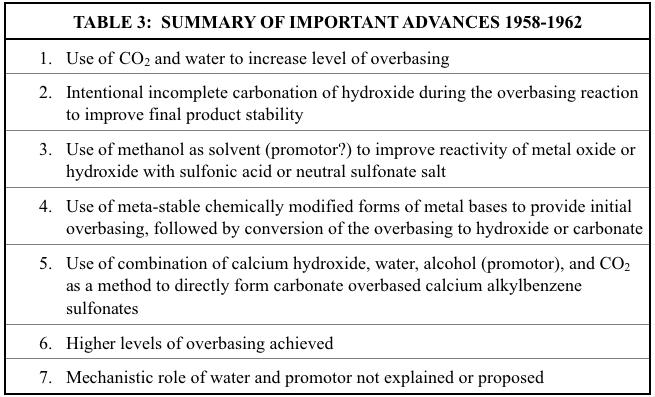
I’m just beginning to see Now I’m on my way It doesn’t matter to me Chasing the clouds away
-Justin Hayward
The important advances mentioned in Table 3, especially items 1-5, catalyzed much new work on further methods to synthesize overbased alkaline earth metal alkylbenzene sulfonates. Unlike much of the earlier work where the more easily overbased barium was the focus, work from this point on focused primarily on calcium.
Two patents issued to Bray Oil Company described methods where calcium oxide or hydroxide was first reacted with CO2 in methanol,. In the first of these two patents, the inventors claimed that calcium carbonate was formed and dispersed in the methanol, and that the dispersion could form a gel structure25. After adding a light organic solvent to thin out the dispersion, it was mixed with either an alkylbenzene sulfonic acid or the neutral sulfonate salt. Heating to strip off the solvents resulted in the final overbased product. Base numbers as high as 350 were taught, although the highest value obtained was 306.
In a modification of this process, calcium oxide was first formed by thermal decomposition of calcium carbonate26. This calcium oxide was then reacted with CO2 in methanol so that no more than 50% of it was converted to a calcium carbonate dispersion. The resulting dispersion was mixed and heated with a sulfonic acid. Additional reaction with CO2 and heat stripping of solvents resulted in a gel. The gel was broken by heating with added water. Base numbers as high as 345 were reported. It is interesting that these two patents claimed that the initial carbonated methanol dispersion contained calcium carbonate. As previously mentioned, a 1960 Continental Oil Company patent23 reported making very similar dispersions, and their work indicated the different structure (11) as shown above.
Several improvements to that Continental Oil Company patent were issued in 1964-1969. In the first one, issued in 1964, Mack Hunt and co-workers, also of Continental Oil Company, used a multi-step process wherein the first step was to react calcium carbide with an alcohol to produce a calcium alkoxide and acetylene.
(12) CaC2 + 2ROH Ca(OR)2 + HCCH
The calcium alkoxide was then carbonated to produce a (13) Ca(OR)2 + CO2 RO-Ca-O-CO-OR
Note the similarity of the final product of (13) with the previous structure (11). The improvement was that when R was properly chosen, the final product of (13) was soluble in the corresponding alcohol ROH. The calcium semi-alkoxide carbonate was then reacted with either an alkylbenzene sulfonic acid or the corresponding neutral calcium sulfonate, followed by hydrolysis to decompose the carbonated alkoxide moiety. The result was a highly overbased calcium sulfonate wherein the overbasing consisted of calcium carbonate. The highest base number achieved was 364.
Two additional improvements to the 1960 Continental Oil Company patent, both issued to Mobil Oil Company, involved partial reaction of calcium carbonate overbased calcium sulfonate with formic acid or with both formic and acetic acid,. The highest base number reported for each of these patents was around 290. Final products were claimed to be superior in high temperature stability for use as motor oil additives.
In 1970, a patent issued to Phillips Petroleum Company described a process where a neutral alkylbenzene calcium sulfonate was reacted with calcium hydroxide, promotor, water, and CO2. What made this process different from the previously discussed 1962 Lubrizol patent24 was that the promotor was an alkylated phenol sulfonic acid. When this promotor was neutralized during the reaction, it became part of the overbased sulfonate structure, and therefore its subsequent removal was unnecessary. The highest TBN value documented from the single example was 150.
Finally, several other important disclosures were made during this time period by Lubrizol. One patent was similar to Lubrizol’s 1962 patent24, but eliminated the need for added water. This feature would become dominant in later work. Barium was the metal most often used in the examples, but it was an overbased calcium sulfonate that had the highest metal ratio. That value of 12.2 was achieved by forming the first overbased calcium sulfonate and then repeatedly reacting it with more CO2 and calcium hydroxide. The inventors redefined the promotor to specifically be monohydric and polyhydric non-aryl alcohols with monohydric alcohols such as methanol being preferred. They also re-iterated the two previous general theories concerning the structure of the highly overbased metal sulfonates: a formal complex where all the overbased metal cations and their anions are incorporated into a truly soluble molecular species; and, a colloidal dispersion where the overbased metal cations and their anions are dispersed by the neutral metal sulfonate. Comments on structure and mechanism will be provided in the final section of this paper.
In 1970, two of the Lubrizol patents dealing with the first overbased calcium sulfonate-based greases documented for the first time the fact that the calcium carbonate that comprised most of the overbasing was devoid of any sign of crystallinity as measured by X-ray diffraction. McMillen and co-workers referred to this as amorphous calcium carbonate. It should be noted that although the term “amorphous”, from the Greek, means “no form”, McMillen and co-workers did not say that the calcium carbonate had no structure whatever, simply that it did not have a measurable crystalline structure. These Lubrizol patents also refined the previous overbasing technology to provide final oil-soluble overbased calcium sulfonates with metal ratios near 20.
Key advances from the patents of this section are summarized below in Table 4.
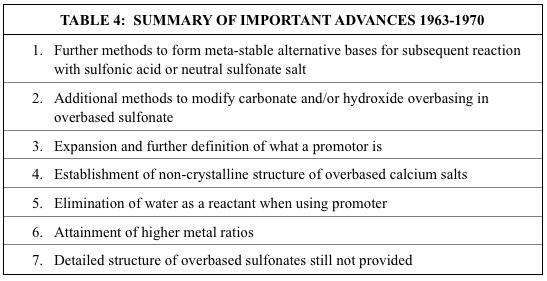
EVENING: THE SUNSET (1970-1984)
I can see it all, from this great height, I can feel the sun, slipping out of sight. And the world still goes on through the night.
-Mike Pinder
By 1970, all subsequent reported work dealt with refinements of technologies already established. Significant work was reported on whether calcium oxide or calcium hydroxide should be used in the overbasing reaction, and on how much should be left after carbonation. Final product clarity and filterability also became increasingly emphasized parameters. In a 1970 patent assigned to Texaco, it was taught that the amount of calcium carbonate formed during carbonation should consume between 50% and 83% of the stoichiometric excess calcium hydroxide used. The inventors further stated that the calcium hydroxide used in the reaction needed to have less than 1.5% calcium carbonate impurity in order to obtain a product with good filterability. Metal ratios were typically around 18 with one example having a value of 20. TBN values were as high as 375. Water was not used in the overbasing reaction, and methanol was the promotor.
In a 1973 patent assigned to Lubrizol, it was further taught that a fully ‘solubilized, homogenous” product could be obtained with as little as 75% of the stoichiometric excess calcium hydroxide converted to the carbonate. This patent also re-stated that the calcium carbonate in the overbased product showed no crystallinity by X-ray diffraction. Metal ratios reported in the examples ranged from 5.2 to about 78.
Another patent assigned to Bray Oil Company in 1975 provided further work related to an earlier patent26. A neutral calcium sulfonate was overbased by reaction of calcium oxide, methanol, and CO2. A base number of 600 was reported for an overbased calcium sulfonate made by four successive iterations of that reaction. Equipment and process flowcharts were described for using their multi-stage process.
Two patents, one issued to Witco Chemical Corporation in 1974, and one issued to Exxon Research & Engineering Company in 1983, continued to use methanol as the preferred promotor (although the Witco patent does not use the term “promotor”) and did not use water as a reactant. Both patents taught carbonation to be done in two distinct steps. In the Witco patent, preferably 90% to 95% of the total calcium oxide or calcium hydroxide was reacted. Base numbers were typically around 300. The Exxon patent differed in the way the temperature was controlled during both carbonation steps. TBN values were typically around 400. Both patents used filtration time as to measure how much of the added calcium hydroxide was utilized.
A 1978 patent assigned to Labofina S.A. taught that using a moderately reactive calcium oxide instead of calcium hydroxide in the overbasing reaction resulted in a product with superior filterability. The base number of the product from the single example was 320.
In a 1984 Texaco patent, the concept of using a very specific mixture of calcium oxide and calcium hydroxide in the overbasing reaction was first introduced. Advantages claimed included improved product clarity and less tendency to form a gelatinous rheology. The inventors also claimed that a promotor was no longer necessary, although in all examples methanol, a previously established promotor, was used. The best final products appeared to be generated when the ratio of calcium oxide to the sum of the oxide and hydroxide was between 0.2 and 0.3. Those final products also had between 5% and 10% of the stoichiometric excess calcium base remaining unreacted after carbonation. Base number values of 400 were provided.
Key advances from the patents of this section are summarized below in Table 5.
EVENING: TWILIGHT TIME (1985-2000)
Twilight time to dream awhile, In veils of deepening blue. As fantasy strides, over colourful skies, Of form disappearing from view.
-Ray Thomas
The U.S. Patents from this period continued the focus described in the previous section, with even more detail towards the further optimization of the reaction process. A patent assigned to Phillips Petroleum Company in 1985 described a continuous reaction process to prepare carbonate overbased calcium sulfonates by reaction of a neutral calcium sulfonate with calcium hydroxide, methanol (the promotor), and CO2. The process involved using a series of reaction vessels in series, with equipment diagrams provided. A critical parameter of the process was the removal of the water formed during the overbasing/carbonation reaction so that its concentration was kept to no more than 1.5% of the reaction mixture. Methanol was also removed during each reaction stage, then re-introduced at a controlled level in the next stage. The inventors taught that this process provided a final product with a TBN of 310.
Nearly one year later, a patent assigned to the inventor, Joanne R. Whittle (previously named as inventor for a Texaco patent40), taught a process of mixing a neutral calcium sulfonate, methanol, calcium oxide, and a hydrocarbon solvent. This was followed by a controlled addition of CO2 and water during a single overbasing/carbonation stage. The inventor claimed the final product had superior filterability compared to products made using a mixture of calcium oxide and calcium hydroxide such as previously taught in her earlier Texaco patent40. TBN values of 300 to 416 were obtained.
Over the next five years, three patents assigned to Texaco Inc. provided what were cast as successive improvements over the previous Whittle patent,,. The first of these patents added the modification of adding 25% to 40% of the required water to the initial mixture of reactants43 . Then the remaining water and CO2 were gradually added at a controlled and uniform rate

to complete the reaction. The inventors taught that previous processes where all the reactant water was added at once or continuously gave a product where part of the overbased calcium carbonate was crystalline and contributed to engine wear. They further taught that their process gave only amorphous calcium carbonate which did not contribute to engine wear. TBN values as high as 470 were taught.
The next Texaco patent was taught as an improvement over the previous one. In this case, a mixture of calcium oxide and calcium hydroxide was used with all the water added in the initial reaction charge44. The added water was to be between 15% and 30% of the moles of calcium oxide used. The inventors claimed that previous overbased calcium sulfonates made from a mixture of calcium oxide and calcium hydroxide were hazy, had higher solids content prior to filtration, and had lower TBN values. They claimed that the products of this most recent process were clear and bright and had lower solids content prior to filtration. TBN values of 400 were reported, and IR spectra showed only amorphous calcium carbonate present.
The next Texaco patent, issued in 1991, had different inventors from the previous two, and it appeared to teach a contrary position45. First, the inventors used only calcium hydroxide as the added base. Second, water was not added as a reactant. The primary feature of this patent was that before 80% of the calcium hydroxide had reacted, a zeolite adsorbent was added to remove reaction bi-product water. The carbonation step was then completed. The authors claimed that nearly all the calcium hydroxide could be converted to calcium carbonate with none of it being crystalline. TBN values up to 447 were achieved. Additionally, the inventors claimed that it was the presence of water near the end of the carbonation step that caused conversion of amorphous calcium carbonate to the crystalline form. They also taught that the previous use of calcium oxide was an attempt to remove water during the carbonation step (by reaction of calcium oxide with water to produce calcium hydroxide), but that this method was not very effective. Finally, they taught that water present near the end of the carbonation step caused an agglomeration of amorphous calcium carbonate within the core of the micelles, and that this “pre-crystallization” was what triggered the conversion to the crystalline form. They based this theory on measured values of the core sizes of amorphous and crystalline overbased calcium sulfonates, both of which were provided.
In 2000, a patent issued to Witco Corporation provided a process whereby a 400 TBN overbased calcium alkylbenzene sulfonate with 100% amorphous calcium carbonate could be converted to an overbased sulfonate with 100% crystalline (calcite) calcium carbonate. The process involved heating the initial overbased sulfonate with water, methanol, diluent hydrocarbon solvent, and either calcium acetate or acetic acid. An optional dispersant could also be included. The final product was clear and bright. TBN values were reported as high as 265, although values as high as 400 were claimed. When added to a commercially established motor oil at 5%(wt), products of this invention decreased the Four Ball Wear (ASTM D4172) scar diameter, thereby showing that their 100% crystalline calcium carbonate overbased calcium sulfonate did not increase wear, at least by the specific test used. Circumstantially, this Witco patent appeared to be something of a rebuttal to the previous Texaco patent that linked crystalline calcium carbonate in overbased calcium sulfonates with increased engine wear.
The refinement of overbased calcium sulfonate technology did not end with this Witco patent. However, this is a good point to end the review, since the successful development of both fully amorphous and fully crystalline 400 TBN overbased calcium sulfonates brings the “development day” to an appropriate nightfall.
Key advances from the patents of this section are summarized below in Table 6.
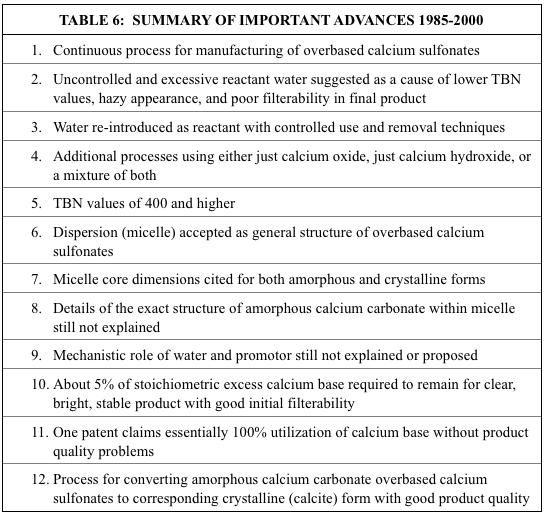
Nights in white satin Never reaching the end…
-Justin Hayward
The night can be a time for reflection of the day that has just ended. This section serves that purpose by summarizing and reflecting on the important topics that run through the U.S. Patents discussed in this review. Three such topics are: barium vs. calcium; evolution of techniques; and structure and mechanism. This is by no means an exhaustive list, but it is a representative one that is appropriate for the scope of this review. The discussion of these three topics will be limited to how they apply to overbased calcium sulfonates where the overbasing is in the amorphous form.
Barium vs. Calcium
The number of patent examples using barium compared to calcium as a function of issuance date is provided in Figure 1.
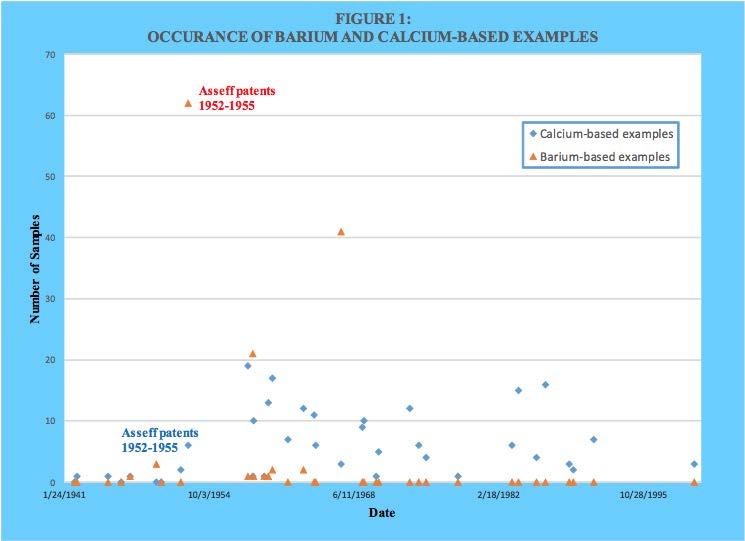
As can be seen, the family of the nine Asseff patents as well as several others used barium as the dominant metal during the earlier years. However, calcium was also used from the beginning and eventually was exclusively used. A comparison of metal ratio values for barium and calcium-based products as a function of issuance date is provided in Figure 2. A similar plot of base number values is provided in Figure 3.
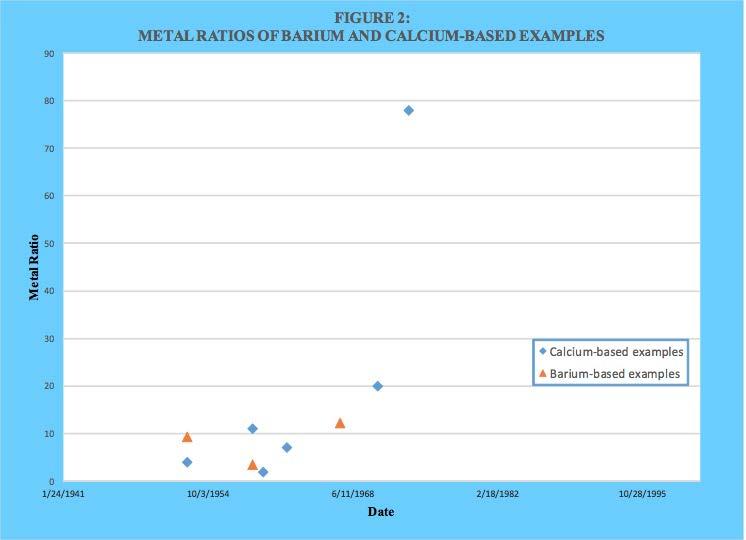
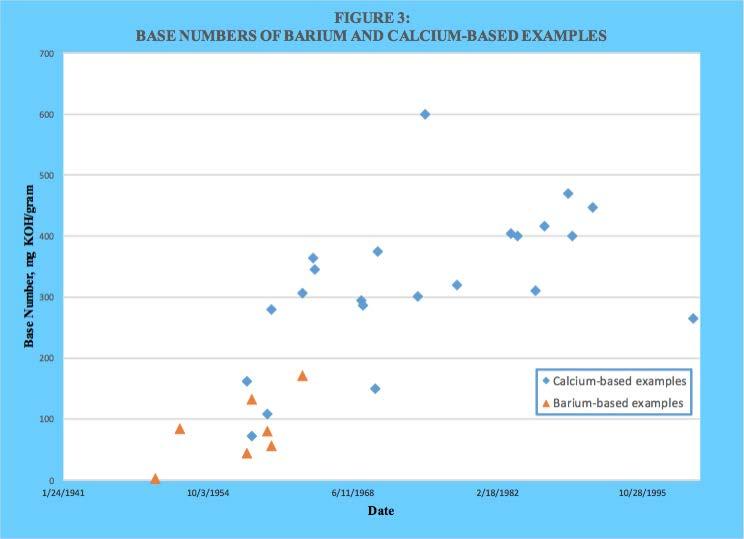
As can be seen, both metal ratio and base number were initially higher with barium. However, calcium-based values quickly dominated as overbasing technology became more effective.
As already mentioned, barium appeared to be easier to be incorporated into an overbased sulfonate structure compared to calcium. However, no stated reason for this could be found within the reviewed patent literature. However, a reasonable explanation can be found from well-known principles of inorganic physical chemistry. The aqueous solubility product constants for calcium carbonate (calcite) and barium carbonate at 25 C are 8.7 x 10-9 and 8.1 x 10-9, respectively. In water there does not appear to be much difference in their solubility. However, the preparation of overbased alkylbenzene sulfonates is not done primarily in an aqueous system. Both barium and calcium bear a 2+ formal charge in their compounds, but a barium cation is significantly larger (1.34 Angstroms) than a calcium cation (0.99 Angstroms). Also, the much greater number of electrons surrounding the barium cation compared to a calcium cation will provide more shielding of the positive charge borne within the nucleus. Both these factors can be expected to result in an effective charge density that is less for a barium cation than a calcium cation. Regardless of the exact structure of the micelle core where the calcium cations and carbonate anions are thought to reside, replacing the calcium with barium would be expected to decrease the affinity between the oppositely charged ions. This would explain why barium sulfonates appeared to be more responsive to most of the overbasing techniques. A brief summary of those techniques is provided next.
Evolution of Techniques
In 1942, the earliest overbased metal alkylbenzene sulfonates were prepared by simply heating an alkylbenzene sulfonic acid with a stoichiometric excess of the metal oxide or hydroxide. Alternatively, a neutral metal sulfonate salt was heated with additional metal oxide or hydroxide. Either way, only a very limited amount of excess metal base could be incorporated in a stable product. By 2000, the technique of getting large amounts of excess calcium to be incorporated into a clear and bright overbased alkylbenzene sulfonate had been developed. In terms of metal ratios, values went from initially being about 2.3 to eventually being 20 or more. The key aspects in this progression of overbasing technology have been captured in the previous Tables 1-6. However, it is useful to distill this technology progression into the following sequence:
1. Direct reaction of calcium oxide/hydroxide with either alkylbenzene sulfonic acid or the corresponding neutral salt 2. Use of water and promotor to increase extent of overbasing 3. Post-reaction with CO2 to convert overbasing anion to carbonate (carbonation) 4. Use of CO2 as an actual reactant to increase extent of overbasing 5. Elimination or limiting of water during the overbasing
reaction 6. Fine tuning of whether to use calcium oxide or calcium hydroxide or both 7. Fine tuning of reaction conditions and separation of final product
Obviously, these seven steps did not occur independently from each other. Neither did one step become complete before another began. However, this progression does suggest certain things regarding the structure of the overbased products and the mechanism by which they were formed. This will be discussed in the final section of this review.
Structure and Mechanism
Given the huge difference in overbasing that exists between the earliest products and those in the final reviewed U.S. Patents, it is nearly certain that the detailed chemical structures are not the same. While the earliest products with metal ratios of about 2.3 could perhaps be something akin to a multicentered complex, such a structure does not seem possible for products that have 20 (or more) times the amount of metal present as what is found in a neutral sulfonate salt. Likewise, the methodology used to make the overbased products with the very high metal ratios strongly suggests that something rather unusual is taking place on the atomic and molecular level.
The overall structure of today’s 400 TBN overbased calcium sulfonates is accepted to be a reverse micelle arrangement with the overbasing moieties within the core. However, the exact arrangement of the core has not been adequately described or demonstrated. Figure 4 provides a typical depiction as found in the open literature.
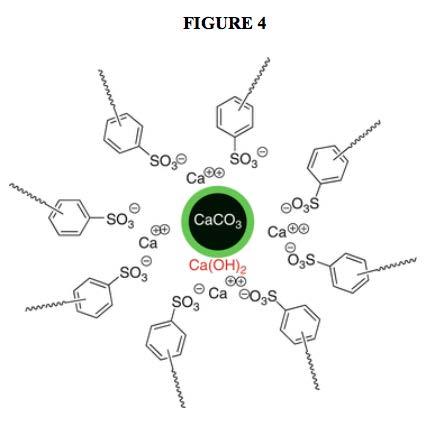
In some other depictions, the core is represented as having a hodgepodge of calcium cations and carbonate anions. In a few depictions, hydroxide anions are added to the hodgepodge. In all such depictions, a possible (if unintentional) implication is that the calcium cations and carbonate anions are present in some manner that is totally devoid of any structure whatsoever. While those who have used such depictions do not actually explicitly indicate this, neither do they indicate anything else concerning any specific and defined core structure. This has the potential of leaving the readers to assume that no core structure of any sort exists. As already mentioned, when the Lubrizol researchers first used the term “amorphous” to describe the calcium carbonate in the highly overbased structure, they did not claim that no structure at all existed. They simply stated that no crystalline structure as measured by X-ray diffraction could be detected.
There are several good reasons based on information discussed within this review that strongly suggest that some kind of structure does exist within the location of the overbasing calcium and carbonate ions.
1. Simple electrostatic considerations make it highly doubtful that a significant number of calcium cations and carbonate anions could exist within the measured dimensions of micelle cores without some kind of structure.
2. In nearly all overbasing techniques a relatively small amount of non-carbonated calcium base (usually the hydroxide) needs to be present so as to provide a final product that is stable. If the calcium cations and carbonate anions are randomly arranged within the core without any structure whatsoever, then why would a small amount of hydroxide anion be important to structural stability?
3. The intricate methodology involving promotor and the careful use of water during and immediately after formation of the overbased sulfonate suggests a special structural arrangement that allows such high levels of excess metal to remain within a clear and bright final product.
The last point is simply an outworking of the inevitable link between a product’s detailed chemical structure and the equally detailed chemical mechanism by which it is formed. The author could find no reference in the open literature that provided an experimentally verified detailed step by step mechanism (with all bond breaking/formation steps and intermediate forms) for any of the modern overbasing technologies that use promotor, CO2, and (sometimes) water to yield 400 TBN overbased calcium sulfonates. Of course, such details may have been worked out decades ago when the technology became well established, and have simply been held proprietary. But if that is the case, then as far as the open literature is concerned, the mechanistic details are still unknown. Even so, any detailed mechanism, published or not, must be able to provide a set of adequate and self-consistent answers to the following questions:
1. What is the exact mechanistic role of the promotor? Specifically, does the promotor become part of the structure of the overbased sulfonate or an intermediate form, and if so, what is that structure?
2. How does the answer to question 1 depend on the chemical structure of the promotor? Why is methanol apparently one of the most effective promotors in terms of how it chemically interacts with the other reactants during the overbasing process?
3. What is the exact mechanistic role of water when used in the overbasing process? Why is too much water at the beginning or near the end of the process detrimental to the extent of overbasing, efficiency of calcium hydroxide/oxide promotion, and final product clarity/filterability? What is the mechanistic relationship between the use of various calcium bases (oxide, hydroxide, or mix of both) and initial presence of water?
4. What is the exact mechanistic role of CO2 when used to simultaneously overbase and carbonate the sulfonate? How is this mechanism different from what occurs when CO2 is used only as a post-treatment for an already formed calcium hydroxide overbased sulfonate? Are any intermediates formed that include the CO2 before the final form of the overbasing sulfonate? If so, what is the mechanistic fate of those intermediates?
5. Why is it important to product stability to have a minor amount of non-reacted calcium hydroxide in the final overbased sulfonate? Is this calcium hydroxide part of any intermediate form, and if so what is the structure? What is the role of that calcium hydroxide in the structure of the final overbased sulfonate?
6. What is the detailed structure of the overbasing moieties (calcium cations, carbonate anions, and hydroxide anions) within the region of the overbased sulfonate where they reside? What are the final mechanistic steps that place these ions within their final orientation?
7. What is the relationship between the detailed mechanism of overbased calcium sulfonate formation and the detailed mechanism of the conversion process by which they are changed into non-Newtonian greases (which also does not appear to be well-documented)?
These seven questions are not a complete list, but they are important. Complete answers to these questions would provide a good place from which significant new technology development could result. Most technology development follows the pattern intentionally used in this paper. The process begins with a dawning of understanding that accelerates, reaches a peak, and then eventually declines, i.e., the typical “S” curve profile. A radical new beginning of technology development usually feeds off of improved understanding and utilization of what has already been documented. A recent example of this was the realization that when the residual calcium hydroxide in an overbased calcium sulfonate was too low, it could affect the structural stability of the grease made from that overbased calcium sulfonate, even if additional calcium hydroxide was added before conversion. The realization of this fact was the basis for an improved understanding of the reaction mechanism of calcium sulfonate complex grease formation previously undocumented in the open literature. That in turn resulted in an advance in calcium sulfonate complex grease technology. One cannot help but wonder what advances could result from a detailed and documented understanding of the structure and formation mechanism of highly overbased calcium sulfonates.
Cold-hearted orb that rules the night Removes the colours from our sight
Red is grey and yellow white
But we decide which is right.
And which is an illusion?
-Graeme Edge
ACKNOWLEDGEMENT
The organizational structure and poetic verse used in this paper are from the iconic 1967 concept album “Days of Future Passed” by The Moody Blues.
